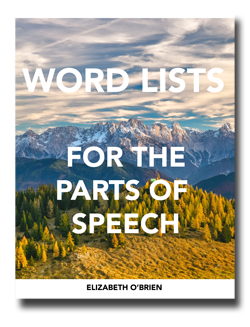Download your free grammar guide here.
Download your free grammar guide here.
Here's a list of prepositions.
Here's a list of prepositions.
- Home
- Word Lists
- List of Prepositions
This list of prepositions will help you understand what a preposition is. But let's start by having you learn the preposition song. Singing this song is an easy way to help you memorize some of the prepositions. I'll sing it for you in the video below. :)
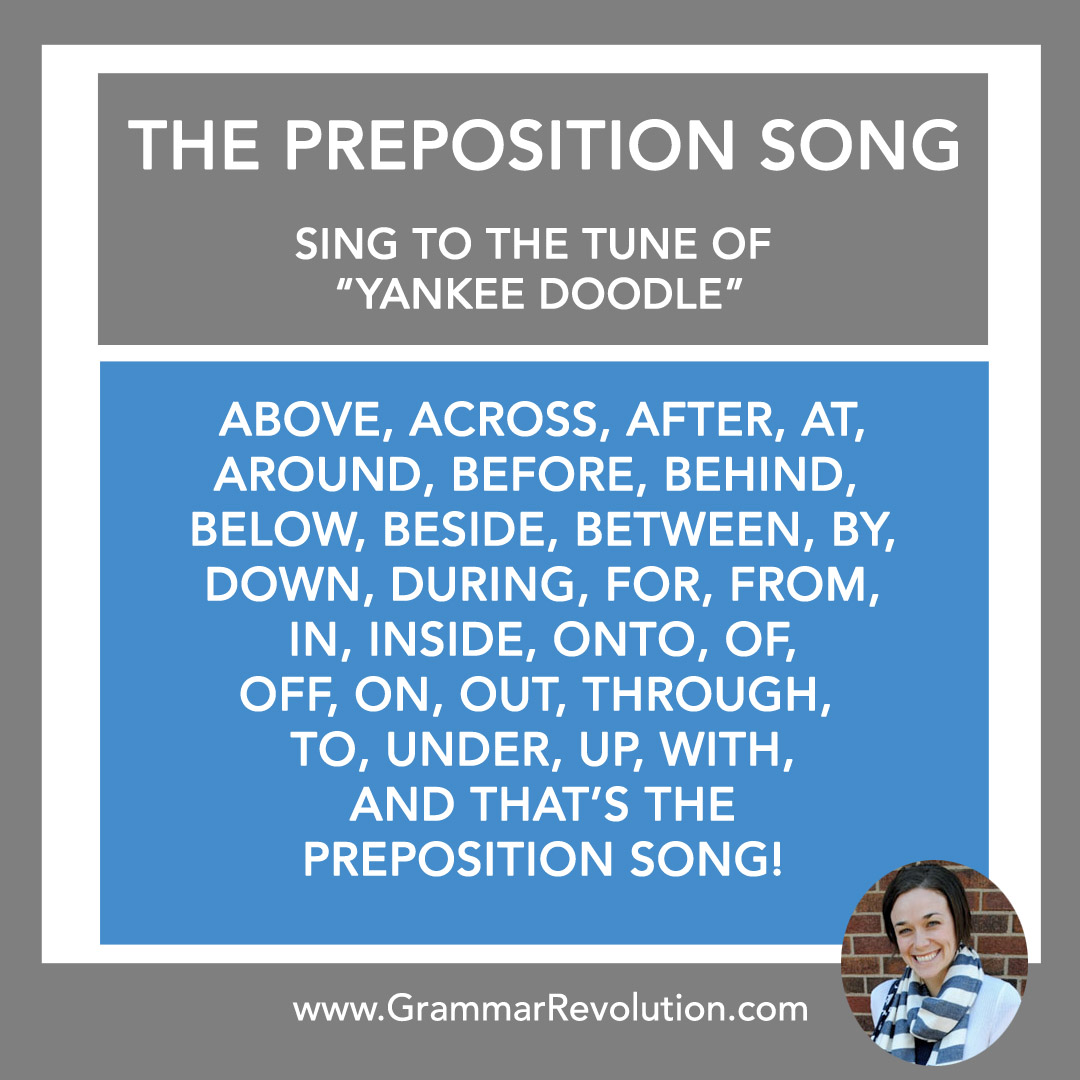
The Preposition Song
above, across, after, at, around, before, behind,
below, beside, between, by, down, during, for, from,
in, inside, onto, of, off, on, out, through,
to, under, up, with
And that's the preposition song!
List of Prepositions
This list contains one-word, two-word, and three-word prepositions. Sometimes, words act together to form one preposition.
WARNING: Keep in mind that the words on this list have the potential to be prepositions. Many of these words can also function as adverbs and other fun things. How can you tell the difference? I'll teach you all the secrets below this list. :)
A aboard, about, above, according to, across, after, against, ahead of, along, amid, amidst, among, around, as, as far as, as of, aside from, at, athwart, atop
B barring, because of, before, behind, below, beneath, beside, besides, between, beyond, but (when it means except), by, by means of
C circa, concerning
D despite, down, due to, during
E except, except for, excluding
F far from, following, for, from
I in, in accordance with, in addition to, in case of, in front of, in lieu of, in place of, in spite of, including, inside, instead of, into
L like
M minus
N near, next to, notwithstanding
O of, off, on, on account of, on behalf of, on top of, onto, opposite, out, out of, outside, over
P past, plus, prior to
R regarding, regardless of
S save, since
T than, through, throughout, till, to, toward, towards
U under, underneath, unlike, until, up, upon
V versus, via
W with, with regard to, within, without
Would you like to download these word lists?
If you'd like to see even more prepositions, check out Wikipedia's list of English prepositions page.
The Mean Thing About This List
(The Secret About Prepositions)
Many times, words on this list of prepositions don't act as prepositions.
That's not very nice, is it? You probably feel a bit like you were tricked. I'm sorry about that. I would change the rules of language if I could so that it would be easier for you to figure all of this out.
Of course, I can't do that, but I can help you use that powerful brain of yours to tell when a word is a preposition and when it's not a preposition. Are you ready? Good.
Here is the one thing that you need to remember: prepositions are ALWAYS in prepositional phrases.
Look at these examples of prepositional phrases with the eye of a detective. What do you notice about them?
I walked to the park.
The cat climbed up the tree.
They biked around the block.
All three of those prepositional phrases begin with a preposition (to, up, around) and end with a noun (park, tree, block), and that sums up what a prepositional phrase is.
Prepositional phrases begin with a preposition (to, up, around) and end with a noun or pronoun called the object of the preposition (park, tree, block).
But why? Why do prepositions need to be in prepositional phrases?
The answer comes to us when we look at the definition of a preposition.
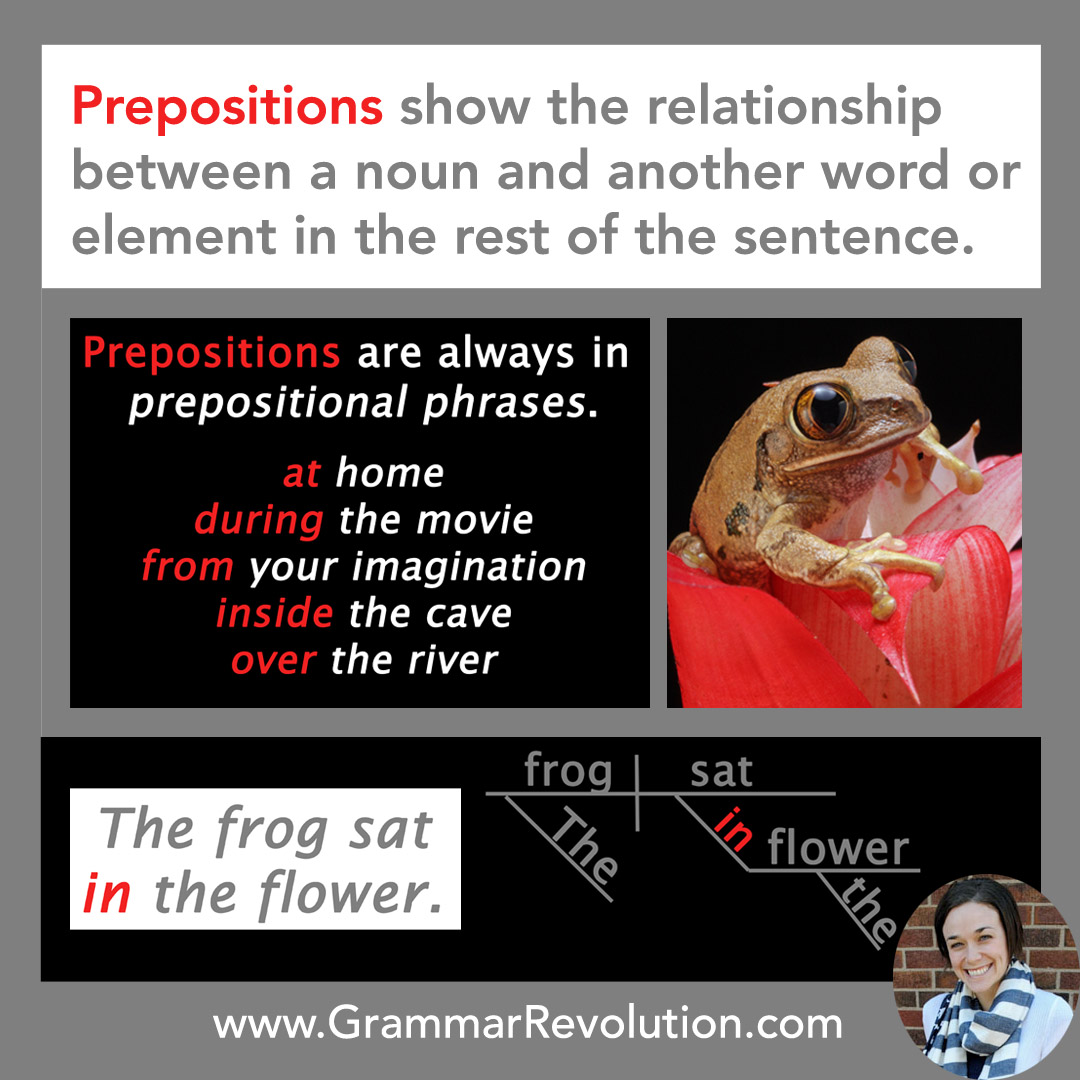
Prepositions are words that show the relationship between a noun/pronoun and some other word in the sentence.
In order for a preposition to do its job (to show the relationship between a noun/pronoun and another word in a sentence), it needs to be followed by that noun or pronoun.
I sense that you may be furrowing your brow in a state of confusion right now, so it's the perfect time for us to look at some sentence diagrams, which will make all of this visual.
Sentence diagrams are pictures of sentences that show us how the words are grammatically related.
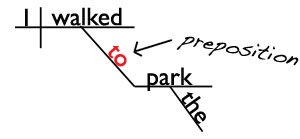
In the diagram, the preposition to, which is on a slanted line, is connecting the noun park with the verb walked. It almost looks like a little bridge, doesn't it? You can think of a preposition as a noun bridge if that helps.
to the park = prepositional phrase
to = preposition
park = noun (object of the preposition)
Prepositional phrases are always diagrammed like that. The preposition goes on a slanted line between the object of the preposition (the noun or pronoun at the end of a prepositional phrase) and a word in the rest of the sentence.
Why? Because the preposition is telling us how that special noun called the object of the preposition relates to the rest of the sentence. It acts as a little noun bridge.
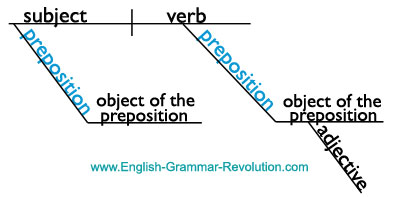
Psst! You can learn more about how to diagram prepositions and prepositional phrases here if you'd like.
Preposition or Adverb?
Did you know that words on the preposition list are often used as adverbs rather than prepositions? It's true! I'm going to use that fact to see if you've been paying attention. Are you ready for a tiny quiz? Great! In which sentence is down a preposition?
A. The cat ran down the tree.
B. The tree fell down.
I'll give you a hint and show you the sentence diagrams of those sentences. (In which diagram is down a bridge between a noun and the rest of the sentence? That's the diagram with the preposition!)
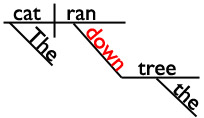
The cat ran down the tree.

The tree fell down.
Are you ready for the answer?
In sentence A, down is a preposition. It's in the prepositional phrase down the tree.
In sentence B, the word down isn't in a phrase, so it's not a preposition. (In this sentence, down is an adverb telling us where the tree fell.)
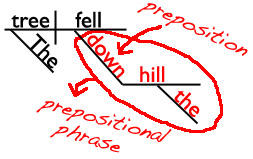
The cat ran down the tree.

The tree fell down.
If you wanted to, you could change sentence B so that down was a preposition instead of an adverb. Can you think of how you would do that?
HINT: Add at least a noun (and probably an adjective as well) after down so that you create a prepositional phrase.
The tree fell down. (adverb)
The tree fell down the hill. (preposition)
Here are two other examples of words from this list functioning as adverbs and as prepositions. I'll bet that you can see the difference now, right?
My sister just walked past. (adverb)
My sister just walked past us. (preposition)
Carefully crawl inside. (adverb)
Carefully crawl inside the tent. (preposition)
The moral of the story is that in order for a word to be a preposition, it must be in a prepositional phrase.
Preposition or Phrasal Verb?
As you saw above, words on this list of prepositions are only potential prepositions. We need to look at how each word-in-question is functioning within a sentence in order to say what part of speech it actually is.
I'm sure you remember that the words on this list are only prepositions when they are in prepositional phrases.
In our last example above (The tree fell down.), you saw how words from the list of prepositions could also function as adverbs.
Another common function of words on this list is for them to be a part of something called phrasal verbs. (I'll underline the phrasal verbs below.) Notice that the words out, up, and off are not prepositions in these sentences.
I work out every Saturday.
He dressed up for the concert.
I was so tired that I nodded off during the class.
Phrasal verbs are two-word or three-word phrases that function as the verb in the sentence. They are made up of a verb (word, dressed, nodded) and a word from the preposition list (out, up, off), and they form a meaning that's different from the meaning that the words have all by themselves.
When words like out, up, and off are in phrasal verbs, they have a special name. They're called particles.
Let's look at a sentence diagram with a phrasal verb. That way, you can see that particles (words from the preposition list that are functioning in phrasal verbs) are not prepositions.
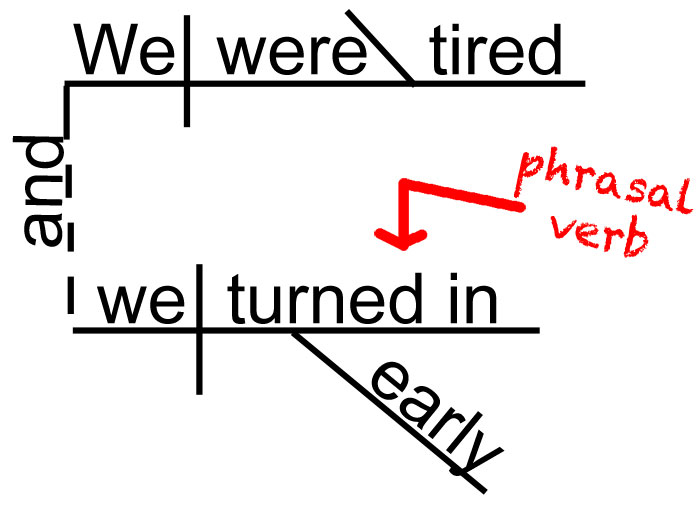
We were tired, and we turned in early.
Look at the sentence diagram and notice that the word in isn't on a little noun bridge. If in were a preposition, it would be diagrammed on a noun bridge like the word to in the diagram below.

Preposition or Conjunction?
I have a feeling that you already know where I'm going with this. :) Some words on this list can also function as conjunctions. Let's look at an example.
A. I'm looking for bananas. (preposition)
B. He felt energized, for he had just won the competition. (conjunction)
In sentence A, for is in the prepositional phrase for bananas.
In sentence B, for is connecting the two clauses he felt energized and he had just won the competition.
Summary
Sometimes it helps to have a summary of everything you've learned. For your learning pleasure, here are the main points we covered on this page.
- Singing some of the prepositions to the tune of "Yankee Doodle" can help you memorize a handful of words from the preposition list.
- Words on the preposition list are not always used as prepositions.
- They are only prepositions when they are in prepositional phrases (preposition + noun).
- Words from the preposition list often act as adverbs. They can also be in phrasal verbs or function as conjunctions. In these cases, they are not prepositions.
Would you like to download these word lists?
This is original content from https://www.english-grammar-revolution.com/list-of-prepositions.html

Hello! I'm Elizabeth O'Brien, and my goal is to get you jazzed about grammar.
Our Free Guide Gives You A Fun Way
To Teach And Learn The Basics v

Elizabeth O'Brien is the creator of Grammar Revolution.
Her lessons are guaranteed to give you more confidence in your communication skills and make you smile. :)
